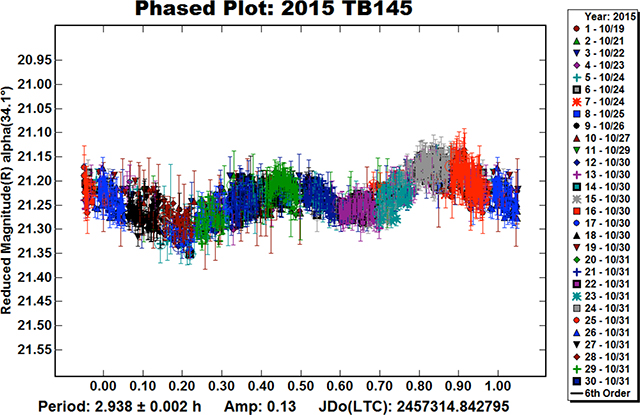Abstract
The near-Earth asteroid 2015 TB145 made a fly-by of Earth in 2015 October. We observed the NEA in support of radar observations planned for late October. Our data set of more than 1200 data points obtained from October 19–31 led to a solution of P = 2.938 ± 0.002 h and A = 0.13 ± 0.02 mag.
The near-Earth asteroid (NEA) TB145 made a fly-by of Earth on 2015 October 31 (~0.003 AU). We responded to a request from the radar team for photometry prior to the fly-by in order to help plan their observations. Tables I and II give the equipment used and the dates of observations for each observer.
Table I.
List of observers and equipment.
| OBS | Telescope | Camera |
|---|---|---|
| Warner | 0.30-m f/9.6 SCT 0.50-m f/8.1 R-C |
FLI ML-1001E FLI PL-1001E |
| Carbognani | 0.81-m f/7.9 R-C | FLI PL-1001E |
| Franco | 0.20-m f/5.5 SCT | ST-7XME |
| Oey | 0.35-m f/5.9 SCT 0.61-m f/6.8 CDK |
ST-8XME Apogee U42 |
Table II.
Dates of observation for each observer. α is the solar phase angle at the earliest and latest observation. The last two columns are the average or extreme phase angle bisector longitude and latitude (see Harris et al., 1984).
| Obs | 2015 Oct | Sess | α | LPAB | BPAB |
|---|---|---|---|---|---|
| Warner | 19–24 26–27 30 |
1–4,6 9–10 12–18 |
33.8 34.7 |
46 54 |
−14 −8 |
| Carbognani | 24 | 5 | 33.9 | 48 | −13 |
| Franco | 31 | 20–30 | 36.4 37.4 |
48–54 | −13 −8 |
| Oey | 24,29,30 | 7–8 11,19 |
33.9 34.8 |
48–51 | −13 −11 |
We began observations at CS3-PDS with the 0.5-m telescope on October 19, when the asteroid was V ~ 18.7 but the sky motion was negligible and so exposures could be long enough (240 s) to 142 get a reasonable SNR. By the end of the month, Franco was using exposures of only 10 sec as the sky motion approached 900”/min.
One of the concerns for a small asteroid is that the rotation period might be very fast, on the order of only a few minutes. To avoid so-called rotational smearing, exposures must be no longer than about 0.19 the rotation period of the asteroid (see Pravec et al., 2000). In this case, the estimated size made it unlikely that the period would be less than about 2 hours, and so the long exposures at the start of the campaign would not be a problem.
All observations were unfiltered. The CS3-PDS observations were referenced to V magnitudes from the MPOSC3 catalog, which is based on the 2MASS catalog converted to the BVRcIc system using formulae developed by Warner (2007). The other observations were referenced mostly to R magnitudes taken either from the MPOSC or UCAC3 catalogs.
All images were measured in MPO Canopus and the data files sent to Warner for period analysis, again using MPO Canopus, which incorporates the FALC Fourier analysis algorithm developed by Harris (Harris et al., 1989). Somewhat arbitrary zero point offsets, for the R magnitudes in particular, were required to find a solution with the minimum RMS deviation that also produced a total lightcurve similar to the individual parts.
The combined data set used 1244 data points for the analysis, which found a solution of P = 2.938 ± 0.002 h and A = 0.13 ± 0.02 mag.
Quite often during a close fly-by, the viewing aspect (phase angle bisector (PAB); see Harris et al., 1984) and/or phase angle change significantly. Either one can cause a noticeable change in the synodic period and/or amplitude over a span of a few weeks, if not days. In this case, neither the PAB or phase angle changed much during the two-week span of observations. Within the limits of the individual data sets, we did not see a noticeable change in either the period or amplitude of the lightcurve.

Acknowledgements
Funding for Warner was provided by NASA grant NNX13AP56G. Research at the Astronomical Observatory of the Aosta Valley Autonomous Region was supported by a 2013 Shoemaker NEO Grant. The Apogee U 42 camera at Blue Mountains Observatory was kindly provided by the 2015 Shoemaker NEO Grant of the Planetary Society.
Contributor Information
Brian D. Warner, Center for Solar System Studies–Palmer Divide Station 446 Sycamore Ave. Eaton, CO 80615 USA
Albino Carbognani, Astronomical Observatory of the Aosta Valley Autonomous Region (OAVdA) Lignan 39, 11020 Nus (Aosta), ITALY.
Lorenzo Franco, Balzaretto Observatory (A81), Rome, ITALY.
Julian Oey, Blue Mountains Observatory (MPC Q68) Leura, NSW, AUSTRALIA.
References
- Harris AW, Young JW, Scaltriti F, Zappala V (1984). “Lightcurves and phase relations of the asteroids 82 Alkmene and 444 Gyptis.” Icarus 57, 251–258. [Google Scholar]
- Harris AW, Young JW, Bowell E, Martin LJ, Millis RL, Poutanen M, Scaltriti F, Zappala V, Schober HJ, Debehogne H, Zeigler KW, (1989). “Photoelectric Observations of Asteroids 3, 24, 60, 261, and 863.” Icarus 77, 171–186. [Google Scholar]
- Pravec P, Hergenrother C, Whiteley R, Sarounova L, Kusnirak P (2000). “Fast Rotating Asteroids 1999 TY2, 1999 SF10, and 1998 WB2.” Icarus 147, 477–486. [Google Scholar]
- Warner BD (2007). “Initial Results of a Dedicated H-G Program.” Minor Planet Bul. 34, 113–119. [Google Scholar]


